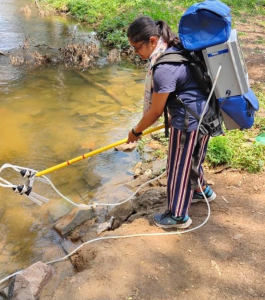CSIR - Centre for Cellular & Molecular Biology
Council of Scientific and Industrial Research
The Innovation Engine of India
Date : August 30, 2024

Hyderabad, 2 nd Nov, 2023: Researchers from the Laboratory for the Conservation of Endangered Species (LaCONES) at the CSIR-Centre for Cellular and Molecular Biology (CCMB), Hyderabad, have developed a new non-invasive method to assess the total biodiversity of any ecosystem by sequencing the DNA fragments found in the environmental samples such as water, soil or air. Their study, published in the journal Ecological Indicators, shows that this method can detect all kinds of organisms, including viruses, bacteria, archaea, and eukaryotes such as fungi, plants, insects, birds, fishes and other animals from just a few litres of water sample without any direct capture or counting of species.
To monitor and conserve biodiversity, scientists need to survey organisms living in different habitats and track their changes over time. But the available biodiversity assessment methods cannot estimate the total species diversity accounting for all the microbes and non-microbes that inhabit an ecosystem. The traditional monitoring methods also require extensive taxonomic expertise, and are not scalable to large ecosystems because they can be expensive, labour-intensive and time-consuming.
To overcome these limitations, the researchers, Mr. S. Manu and Dr. G. Umapathy at CSIR-CCMB developed a lysis
and PCR-free molecular approach to extract and read the genetic information encoded in free-floating environmental DNA (eDNA). eDNA is DNA shed by all organisms into their surroundings through natural processes during their lifetime or after death.
In this new method, the researchers filter out eDNA from environmental samples, read their sequences, and thus, identify the source of the eDNA. They tested their method in the highly biodiverse wetland ecosystem of Chilika Lagoon in Odisha, India’s largest brackish water lagoon, with the Chilika Development Authority’s help.
By comparing over 10 billion sequences of eDNA fragments from multiple seasonal samples with a large database of reference sequences from all the known species, the researchers were able to detect organisms across the tree of life. They estimated that the total taxonomic diversity of Chilika Lagoon is about 1071 families across the tree of life, comprising approximately 799 families of eukaryotes, 230 families of bacteria, 27 families of archaea, and 13 families of DNA viruses. The researchers also found the relative abundances of families of organisms vary significantly across different locations and seasons in the ecosystem. This indicates that the method can also help monitor the changes in biodiversity across space and time.
“The current methodologies for eDNA-based bioassessment are limited to approaches where only specific species or groups of related taxa are looked for. We worked around this problem and improved detection of organisms, from microbes to mammals, even if they are low in abundance. And we can detect all those organisms whose reference genome sequences are known,” says S. Manu, a PhD student at CCMB who carried out the study. This has helped the new method to detect many kinds of organisms that are otherwise not detected through existing molecular biology tests.
Dr. G. Umapathy, Senior Principal Scientist who supervised the study also commented on the universality of the method. He said, “This method can be efficiently applied in different types of ecosystems to assess the total biodiversity and monitor the biodiversity loss due to anthropogenic factors to inform data-driven conservation efforts in large areas.”
Dr. Vinay K. Nandicoori, Director, CCMB said, “This cutting-edge method using eDNA to assess the entire diversity of ecosystems is cheaper, faster, and highly scalable to large freshwater and marine ecosystems which can help in monitoring and conserving the rich biodiversity of our country”.
Manu, S., & Umapathy, G. Deep sequencing of extracellular eDNA enables total biodiversity assessment of ecosystems. Ecological Indicators. 31st October, 2023.
https://doi.org/10.1016/j.ecolind.2023.111171
Dr. G. Umapathy
Senior Principal Scientist and Group Leader
CSIR-Centre for Cellular and Molecular Biology
Hyderabad, India
Email: guma@ccmb.res.in
 Advertisement no 07/10 for the post Junior Scientist.
Advertisement no 07/10 for the post Junior Scientist.
 List of shortlisted candidates for the temporary positions against CCMB Web Notif.No.0724/B- [26-08-2024]
List of shortlisted candidates for the temporary positions against CCMB Web Notif.No.0724/B- [26-08-2024]
 Result of selected candidates for the temporary positions against CCMB Web Notif.No.0724/A - [21-08-2024]
Result of selected candidates for the temporary positions against CCMB Web Notif.No.0724/A - [21-08-2024]
 Notification of Schedule for Trade Test and Downloading of Admit Cards for the posts of Gr. II (1)/Technician (1) against Advt.No:01/2021 - [19-08-2024]
Notification of Schedule for Trade Test and Downloading of Admit Cards for the posts of Gr. II (1)/Technician (1) against Advt.No:01/2021 - [19-08-2024]
 List of selected candidates for the temporary positions against CCMB Web Notif.No.0624/A - [14-08-2024]
List of selected candidates for the temporary positions against CCMB Web Notif.No.0624/A - [14-08-2024]
 List of shortlisted candidates for the temporary positions against CCMB Web Notif.No.0724/A - [02-08-2024]
List of shortlisted candidates for the temporary positions against CCMB Web Notif.No.0724/A - [02-08-2024]
 Notification No.0824/A for various temporary positions on contractual basis- [02-08-2024]
Notification No.0824/A for various temporary positions on contractual basis- [02-08-2024]
 Notification No.0724/B for various temporary positions on contractual basis - [29-07-2024]
Notification No.0724/B for various temporary positions on contractual basis - [29-07-2024]
 List of shortlisted candidates for the temporary positions against CCMB Web Notif.No.0624/A- [19-07-2024]
List of shortlisted candidates for the temporary positions against CCMB Web Notif.No.0624/A- [19-07-2024]
 List of Provisionally empanelled candidates for Engagement as Project staff Vide Notif.No.2024/1 - [15-07-2024]
List of Provisionally empanelled candidates for Engagement as Project staff Vide Notif.No.2024/1 - [15-07-2024]